Guru Nanak Dev Ji ( ਗੁਰੂ ਨਾਨਕ) [1469-1539]
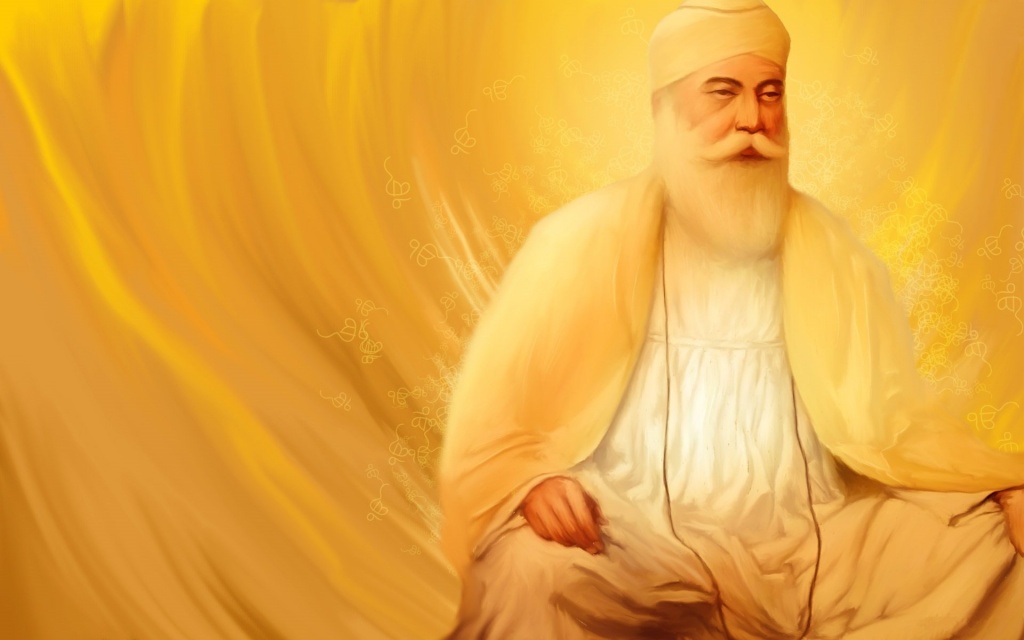
By the age of 16, Guru Nanak Dev ji had mastered multiple religious texts and languages including Sanskrit, Persian, and Hindi, and was writing what many believed were divinely inspired compositions.
Guru Nanak Dev Ji the founder and first Guru of Sikhism, was born in the year 1469, in the village Talwandi which is now known as Nankana Sahib in Punjab Pakistan. Blessed with a deeply contemplative mind and rational thinking, young Nanak ji would often astound his elders and teachers with the sublimity of his knowledge, particularly on divine matters. Growing up, he refused to partake in traditional religious rituals, and often spoke out against several prevalent societal practices such as the Caste System, idolatry, and the worship of demi-Gods.

By the age of 16, Guru Nanak Dev ji had mastered multiple religious texts and languages including Sanskrit, Persian, and Hindi, and was writing what many believed were divinely inspired compositions.
Guru Nanak Dev Ji the founder and first Guru of Sikhism, was born in the year 1469, in the village Talwandi which is now known as Nankana Sahib in Punjab Pakistan. Blessed with a deeply contemplative mind and rational thinking, young Nanak ji would often astound his elders and teachers with the sublimity of his knowledge, particularly on divine matters. Growing up, he refused to partake in traditional religious rituals, and often spoke out against several prevalent societal practices such as the Caste System, idolatry, and the worship of demi-Gods.
The Origin of Sikhism
Sikhism was born in the Punjab around 1500 CE, when Guru Nanak began teaching a faith. Nine Gurus followed Nanak and developed the Sikh faith and community over the next centuries. Sikhism was well established by the time of Guru Arjan, the fifth Guru who completed the establishment of Amritsar as the capital of the Sikh world, and compiled the first authorised book of Sikh scripture, the Adi Granth. However, during Arjan’s time Sikhism was seen as a threat by the state. The sixth Guru, Hargobind, started to militarise the community for self-defence. . Aurangzeb had the ninth Guru, Tegh Bahadur, arrested and executed in 1675. The tenth and last Guru, Gobind Singh, established the Sikh rite of initiation (called khandey di pahul) and the 5 Ks which give Sikhs their unique appearance. In 1799 Ranjit Singh captured Lahore, and in 1801 established the Punjab as an independent state, with himself as Maharaja. He proved an adept ruler of a state in which Sikhs were still in a minority. After Ranjit Singh died in 1839 the Sikh state crumbled, damaged by vicious internal battles for the leadership. In 1845-6 troops of the British Empire defeated the Sikh armies, and took over much Sikh territory. The Sikhs rebelled again in 1849, and were defeated by the British, this time conclusively.
Sikhism was born in the Punjab around 1500 CE, when Guru Nanak began teaching a faith. Nine Gurus followed Nanak and developed the Sikh faith and community over the next centuries. Sikhism was well established by the time of Guru Arjan, the fifth Guru who completed the establishment of Amritsar as the capital of the Sikh world, and compiled the first authorised book of Sikh scripture, the Adi Granth. However, during Arjan’s time Sikhism was seen as a threat by the state.
The sixth Guru, Hargobind, started to militarise the community for self-defence. . Aurangzeb had the ninth Guru, Tegh Bahadur, arrested and executed in 1675. The tenth and last Guru, Gobind Singh, established the Sikh rite of initiation (called khandey di pahul) and the 5 Ks which give Sikhs their unique appearance. In 1799 Ranjit Singh captured Lahore, and in 1801 established the Punjab as an independent state, with himself as Maharaja. He proved an adept ruler of a state in which Sikhs were still in a minority. After Ranjit Singh died in 1839 the Sikh state crumbled, damaged by vicious internal battles for the leadership. In 1845-6 troops of the British Empire defeated the Sikh armies, and took over much Sikh territory. The Sikhs rebelled again in 1849, and were defeated by the British, this time conclusively.
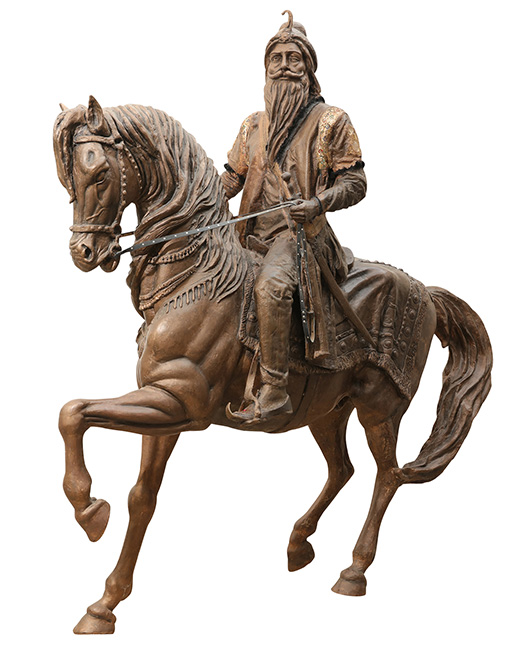
Ranjit Singh was the ruler of a powerful State extending from Tibet to Sindh and from the Khyber pass to the Sutlej. Kingdoms and empires have almost invariably been founded and maintained on the strength of arms. Ranjit Singh gave to Punjab four decades of peace, prosperity and progress. Benefits of this were enjoyed equally by all communities — Muslims, Hindus and Sikhs. There was complete freedom of expression and worship enjoyed by all his subjects. He did not proclaim Sikhism as the religion of the state. His gave due respect to all religions. Recruitment to all posts in his state was to be made on merit. For the first time in Indian history, the centuries-old untouchables of Hindu society become a regular component of Ranjit Singh’s army. He attributed each success to the favour of God. When he issued the coins of his empire, he struck them not in his own name, but in the name of the Guru. During his 40-year-long reign not even one person was sentenced to death. Ranjit Singh’s state was the most progressive state in India.
Ranjit Singh was the ruler of a powerful State extending from Tibet to Sindh and from the Khyber pass to the Sutlej. Kingdoms and empires have almost invariably been founded and maintained on the strength of arms. Ranjit Singh gave to Punjab four decades of peace, prosperity and progress. Benefits of this were enjoyed equally by all communities — Muslims, Hindus and Sikhs. There was complete freedom of expression and worship enjoyed by all his subjects.
He did not proclaim Sikhism as the religion of the state. His gave due respect to all religions. Recruitment to all posts in his state was to be made on merit. For the first time in Indian history, the centuries-old untouchables of Hindu society become a regular component of Ranjit Singh’s army. He attributed each success to the favour of God. When he issued the coins of his empire, he struck them not in his own name, but in the name of the Guru. During his 40-year-long reign not even one person was sentenced to death. Ranjit Singh’s state was the most progressive state in India.
The-Sikh Legacy in Punjab
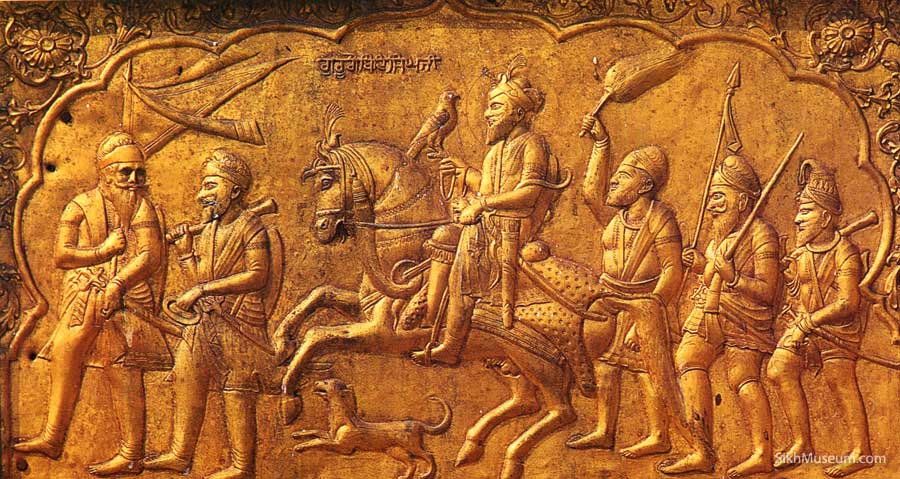
Sikh Architecture, is a style of architecture that is characterised with values of progressiveness, exquisite intricacy, austere beauty and logical flowing lines. This form of architecture was initially developed within Sikhism its style is used in many non-religious building due its beauty. 300 years ago, Sikh architecture was distinguished for its many curves and straight lines, Shri Keshgarh Sahib and the Golden Temple are prime examples and history of a gurdwara. Apart from buildings of religious order, Sikh architecture has secular types of forts, palaces, colleges, etc. The religious structure is the gurdwara, a place where the Guru dwells. A gurdwara is not only the all-important building of the Faith, as masjid or mosque of the Islamic faith and mandir or temple of the Hindu religion, but it is also, like its Islamic and Hindu counterparts, the keynote of Sikh architecture.
Sikh Architecture, is a style of architecture that is characterised with values of progressiveness, exquisite intricacy, austere beauty and logical flowing lines. This form of architecture was initially developed within Sikhism its style is used in many non-religious building due its beauty. 300 years ago, Sikh architecture was distinguished for its many curves and straight lines, Shri Keshgarh Sahib and the Golden Temple are prime examples and history of a gurdwara.
Apart from buildings of religious order, Sikh architecture has secular types of forts, palaces, colleges, etc. The religious structure is the gurdwara, a place where the Guru dwells. A gurdwara is not only the all-important building of the Faith, as masjid or mosque of the Islamic faith and mandir or temple of the Hindu religion, but it is also, like its Islamic and Hindu counterparts, the keynote of Sikh architecture.
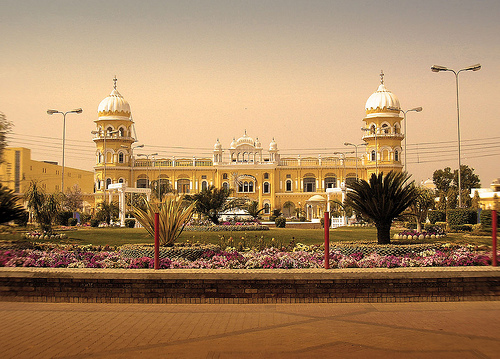
Gurdwara Janam Asthan Guru Nanak Dev!!
Nankana Sahib is a city where Guru Nanak, the founder of Sikhism, was believed to be born in 1469. The city was previously known as Talwandi, and was founded by Rai Bhoi, a wealthy landlord it was renamed as ‘Nankana Sahib’ in honour of the Guru. ‘Sahib’. The Janam Asthan shrine was constructed by Maharaja Ranjit Singh, after he visited Nankana Sahib in 1818-19 while returning from the Battle of Multan.

Gurdwara Janam Asthan Guru Nanak Dev!!
Nankana Sahib is a city where Guru Nanak, the founder of Sikhism, was believed to be born in 1469. The city was previously known as Talwandi, and was founded by Rai Bhoi, a wealthy landlord it was renamed as ‘Nankana Sahib’ in honour of the Guru. ‘Sahib’. The Janam Asthan shrine was constructed by Maharaja Ranjit Singh, after he visited Nankana Sahib in 1818-19 while returning from the Battle of Multan.
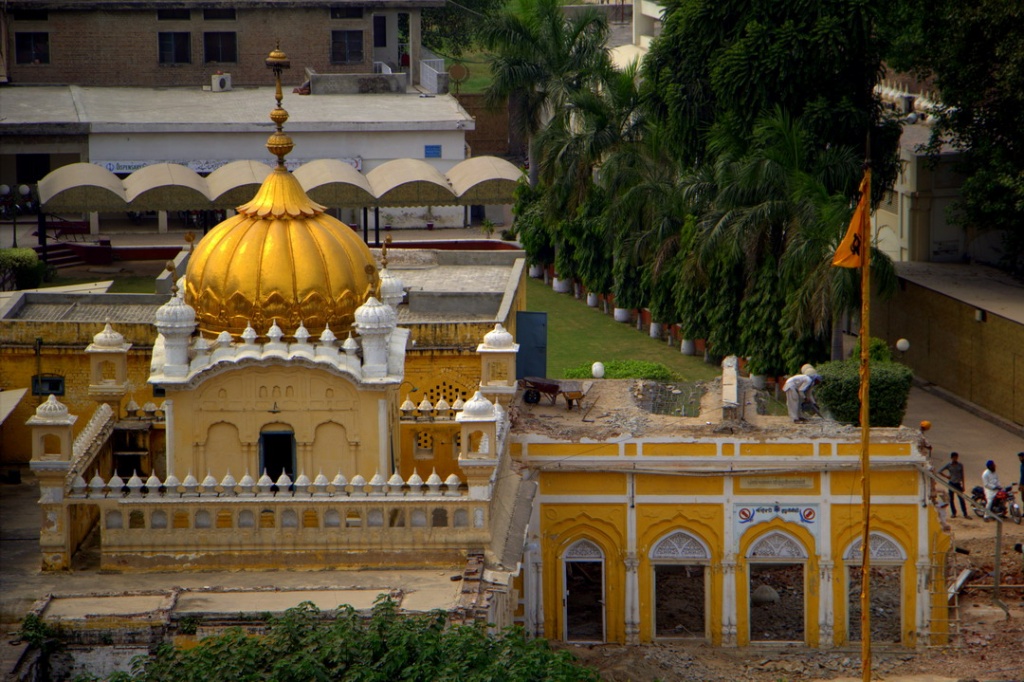
Samadhi of Ranjit Singh – a sight of religious harmony!!
Maharaja Ranjit Singh was born in 1780 in Gujranwala As per Sikh History. The Samadhing about is the mausoleum of the Ranjit Singh. It is located near the Lahore Fort and Badshahi Mosque in Lahore. Its construction was started by Maharaja Ranjit Singh’s son, Kharak Singh, on the spot where Ranjit was cremated, and was completed by his youngest son, Duleep Singh, in 1848. The Samadhi is a beautiful blend of Hindu, Sikh and Muslim architectural styles. The front of the doorway has images of Ganesh, Devi and Brahma, the Hindu deities, cut in red sand stone. The ceilings are decorated with glass mosaic work. Maharaja Ranjit Singh’s ashes are in a marble urn in the shape of a lotus, in the centre of the tomb.

Samadhi of Ranjit Singh – a sight of religious harmony!!
Maharaja Ranjit Singh was born in 1780 in Gujranwala As per Sikh History. The Samadhing about is the mausoleum of the Ranjit Singh. It is located near the Lahore Fort and Badshahi Mosque in Lahore.
Its construction was started by Maharaja Ranjit Singh’s son, Kharak Singh, on the spot where Ranjit was cremated, and was completed by his youngest son, Duleep Singh, in 1848. The Samadhi is a beautiful blend of Hindu, Sikh and Muslim architectural styles. The front of the doorway has images of Ganesh, Devi and Brahma, the Hindu deities, cut in red sand stone. The ceilings are decorated with glass mosaic work. Maharaja Ranjit Singh’s ashes are in a marble urn in the shape of a lotus, in the centre of the tomb.
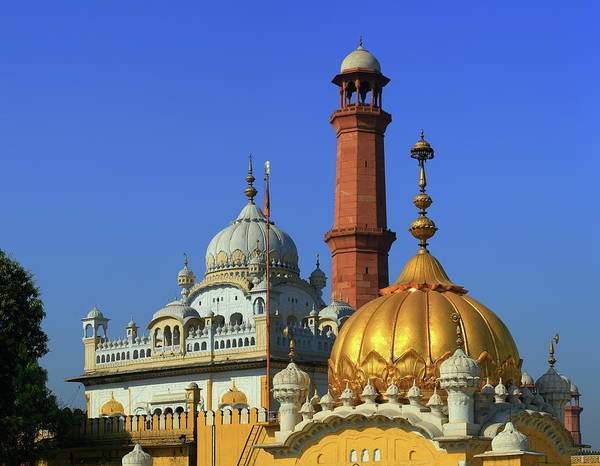
Gurdwara Dera Sahib Sri Guru Arjan Dev — an epitome of fine heritage and holiness
Gurdwara Dera Sahib is a Sikh temple in Lahore, which commemorates the spot where the 5th guru of Sikhism, Guru Arjan Dev, was martyred in 1606. The gurdwara is located just outside of the Walled City of Lahore, and is part of an ensemble of monuments which includes the Lahore Fort, Samadhi of Ranjit Singh, Hazuri Bagh quadrangle, Roshnai Gate, and the Badshahi Mosque.

Gurdwara Dera Sahib Sri Guru Arjan Dev — an epitome of fine heritage and holiness
Gurdwara Dera Sahib is a Sikh temple in Lahore, which commemorates the spot where the 5th guru of Sikhism, Guru Arjan Dev, was martyred in 1606. The gurdwara is located just outside of the Walled City of Lahore, and is part of an ensemble of monuments which includes the Lahore Fort, Samadhi of Ranjit Singh, Hazuri Bagh quadrangle, Roshnai Gate, and the Badshahi Mosque.
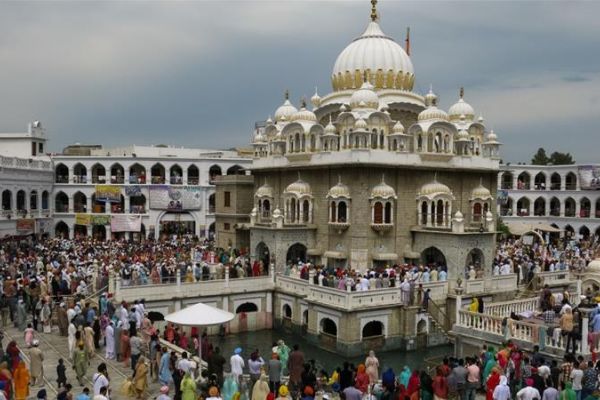
Gurdawara Panja Sahib — a symbol of peace!!
Gurdawara Panja Sahib is located in Hassanabdal, 48 kilometres from Rawalpindi. Visited by both Hindus and Sikhs for pilgrimage twice a year, the Gurdawara or temple, has been a symbol of peace for over three centuries. The word ‘Panja’ means the palm of the hand in Punjabi. According to legend, a holy man hurled a rock towards Guru Nanak who stopped the rock with his hand, leaving an imprint on it. The holy man, upon seeing this, became Guru Nanak’s devotee. The rock with the handprint has been preserved in its original shape and can be seen by visitors today. Courtesy: DAWN

Gurdawara Panja Sahib — a symbol of peace!!
Gurdawara Panja Sahib is located in Hassanabdal, 48 kilometres from Rawalpindi. Visited by both Hindus and Sikhs for pilgrimage twice a year, the Gurdawara or temple, has been a symbol of peace for over three centuries.
The word ‘Panja’ means the palm of the hand in Punjabi. According to legend, a holy man hurled a rock towards Guru Nanak who stopped the rock with his hand, leaving an imprint on it. The holy man, upon seeing this, became Guru Nanak’s devotee. The rock with the handprint has been preserved in its original shape and can be seen by visitors today. Courtesy: DAWN


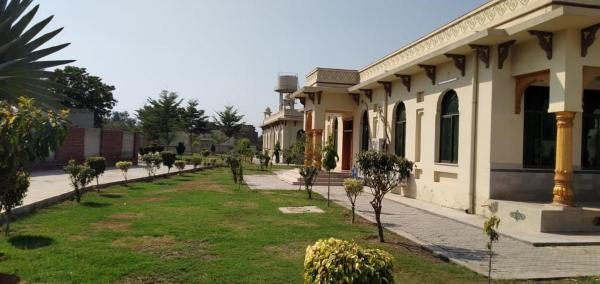
Book a Spiritual tour with TDCP!!
TDCP Hotel One Nankana is an elegantly furnished hotel offering impeccable room standards and furnishings. Enjoy vast lush green landscaping and walking tracks nearby, offering a chance to escape the hassles of the city. The hotel offers mouthwatering food prepared by skilled chefs. The hotel is situated near several notable places of Nankana, such as Gurdwara Janam Asthan and Quba Masjid. The city is known for its monuments and traditional architecture. For Gotel booking please contact.
Address: Hospital Road Near Stadium, Nankana Sahib, 39100 Nankana Sahib, Pakistan
TEL: 0092-56-2874200 / 0092-3184182669
E-MAIL: hotelone.nankana@hotelone.com.pk

- Bhai Ram Singh: Inventor And Master Of Sikh Architecture – A Tribute By Dr SS Bhatti
- Understanding Sikh Architecture through the Sikh Shrines in East Punjab
- Reconsidering Sikh architecture: The Sama̅dhi of Maharaja Ranjit Singh in Lahore
The Sikh heritage in Pakistan by Ishtiaq Ahmed published in Daily Times MARCH 9, 2018
Haveli Naunihal Singh — a jewel in the heart of Lahore by Salman Ali MARCH 22, 2018

